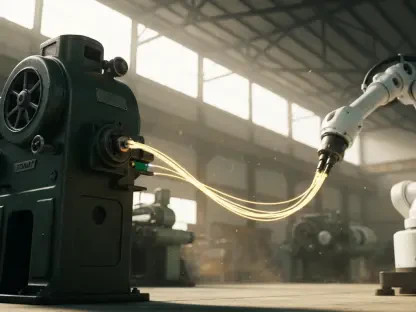In a transformative leap for soft robotics, researchers at Rice University have pioneered a groundbreaking robotic arm that harnesses light and artificial intelligence to achieve unparalleled motion precision. Traditional robotics have often been limited by the mechanical rigidity inherent in their design, compromising flexibility and application breadth. This innovation circumvents these limitations by leveraging smart materials combined with machine learning and an optical control system, eliminating the need for cumbersome onboard electronics. This advancement holds transformative potential for diverse applications, from biomedical environments requiring delicate manipulation to dynamic industrial processes.
Key Innovations and Methods
Development of the Robotic Arm
The creation of this sophisticated robotic arm marks a monumental milestone in robotics technology, particularly because it utilizes the azobenzene liquid crystal elastomer—a light-responsive material that offers nuanced control of movement. By employing a spatial light modulator, researchers from the team led by Hanyu Zhu and Elizabeth Blackert were able to split a single laser beam into multiple subordinate beams. This subdivision allows precise control over the robotic arm’s complex motions, dramatically enhancing the degree of freedom available beyond the capabilities of conventional robots.
A distinctive feature of this system is its ability to manipulate the elastomer’s shape solely through light exposure, dispensing with the traditional physical constraints imposed by wires and electronics. This bio-inspired approach—akin to how plants orient themselves toward sunlight—suggests vast adaptability and application potential. Further, the azobenzene material’s unique propensity to respond to specific light frequencies extends control possibilities and application diversity, offering tailor-made solutions in areas where environmental sensitivity and movement precision are critical.
Optical Control Systems
The optical control system underpinning the robotic arm is central to its operation, empowering the precise manipulation of the smart materials within it. By implementing a spatial light modulator, the system splits singular laser beams into multiple streams that target different sections of the arm, leading to finely tuned adjustments and movements. Patterns of light direct movements with uncanny accuracy, mimicking natural motion dynamics and virtually erasing the limitations found in conventional robots constrained by preset mechanical sequences.
Additionally, the innovative control system alleviates the need for physical connections or computations from onboard circuitry, streamlining design and improving functionality. While conventional robotics demand intricate mechanical frameworks to achieve comparable motion, this optical control system simplifies the process through direct and responsive actions in real-time. Moreover, the absence of electronic components contributes to a reduction in energy consumption, facilitating environmentally conscious solutions while expanding potential uses in fields like optical surgery or high-precision manufacturing environments.
Machine Learning Integration
Training the Neural Network
Integral to this cutting-edge development is the use of advanced neural networks, which play an essential role in facilitating complex arm movements by determining necessary light patterns. These networks are trained through a comprehensive data-gathering process, consisting of diverse light settings and resultant arm deformations. Utilizing convolutional neural networks similar to those in image recognition, the data collected is transformed into predictive models that determine light configurations needed for specific robotic movements, effectively automating and simplifying operational complexity.
Through machine learning integration, researchers circumvent the traditional manual input requirements, resulting in heightened precision and capability for the robotic arm to perform a range of tasks, from intricate navigation around obstacles to seamless interaction with delicate objects. Continuous learning processes foster adaptability in the technology, ensuring the robotic arm remains capable of handling evolving demands in professional applications, whether in surgical tools or automated manufacturing systems. Machine learning serves as the backbone for incremental advancement in design and functionality, allowing for incremental adaptation and reassessment of application potential.
Expanding Capabilities with Artificial Intelligence
Artificial intelligence integration within this context represents an evolution beyond traditional robotics, enabling functions previously unattainable through manual programming alone. By employing deep learning models, the robotic arm achieves dexterity that mimics human movements, rendering it capable of actions necessitating both precision and adaptability. The neural network effectively provides the intellectual framework required for this machine operation, translating learned experiences into decisions that influence real-world actions across diverse scenarios.
AI advancements not only elevate operational capacity but also facilitate adaptive learning, allowing the robotic arm to continuously improve its performance. As the system encounters various task sets, it revises its actions through iterative learning, posing opportunities to expand into more sophisticated applications and environments. This dynamic adaptability ensures broader integration capabilities, from therapeutic settings where sustained precision is imperative to production lines requiring versatility in goods handling. AI integration illustrates robotics transitioning into intelligent entities capable of autonomous functioning and responsive adaptation to shifting conditions, forging pathways for future developments in robotics applications.
Addressing the Challenges of Soft Robotics
Resolving Limitations
The development of this light-driven robotic arm addresses numerous challenges that have historically constrained soft robotics, such as the inherent balance between mobility complexity, and functional execution. Traditional robots, with their rigid and often inefficient joint mechanisms, have struggled to attain fluid motion compared to their softer counterparts, which generally suffer from pre-determined functional limitations or tethered designs. Researchers at Rice University have strived for innovation by merging unique properties of the azobenzene liquid crystal elastomer with sophisticated AI and optical technology, thereby producing robotic systems with untethered, fully programmable potential.
Moreover, the elastomer’s ability to shrink in response to blue laser light and restore its shape in darkness—features not found in earlier light-sensitive materials—completes a cycle allowing for real-time control without exposure to hazardous ultraviolet light. This key material characteristic assures safety and an increased cycle response speed, marking significant advancement over previous materials used in similar applications, while also contributing to reduced energy expenses. These properties collectively enhance the robot’s effective range and deployment versatility, paving the way for expanded uses where mobility and environmental resilience inform functional logic.
Advancements in Material Design
The reception of azobenzene as a fundamental element in soft robotics has ushered in new standards for material integration with innovative design principles. The material’s response to specific light stimuli marks a revolutionary approach that combines flexibility, safety, and efficiency. Its chemically engineered structure ensures a unique response to light patterns, fostering applications requiring high precision in movement and configuration. Complementing this design is the lightweight, dynamic composition permitting effortless movement enhancements, indicative of promising opportunities across various sectors demanding functional dexterity.
Furthermore, this material emerges as a versatile substrate accommodating transformative uses across fields beyond the current scope, such as life sciences and aerospace technology. It not only provides durable solutions but also responds reliably to environmental factors, establishing conditions for expanded operational deployment in future technological ecosystems. As advancements in material chemistry continue to unfold, the applications of azobenzene are poised to traverse conventional boundaries, offering possibilities for growth in unprecedented areas while supporting the advancement of soft robotics to new heights. Material emphasis sets a precedence for modern robotics design, committed to aligning safe and intelligent technology with innovative material development.
Applications and Future Directions
Potential Medical Applications
Soft robotics developed with light-driven motion and AI integration show promising potential across diverse domains, particularly within medical settings where precision and non-invasive mechanics inform the necessity for delicate operations. The robotic arm’s ability to offer gentle manipulation makes it an ideal candidate for surgical devices that require precision intervention without imposing risks associated with traditional models. The combinational application of AI and elastomer properties guarantees safe and agile operation, allowing for pioneering developments in minimally invasive strategies focused on patient-centric solutions.
Additionally, the arm’s adaptability in environments demanding consistent accuracy addresses growing challenges in healthcare, ensuring adherence to evolving health practices while offering innovative tools to professionals. Expansion into real-world applications becomes feasible with continuous improvements and responsiveness leveraged from AI and material dynamics, prompting potential adaptive solutions in therapeutic robotics. The ongoing commitment toward healthcare optimization through robotics signifies the expansive scope of opportunities within the field while facilitating new narratives dedicated to enhancing patient care paths.
Industrial Impact
The influence of this advanced robotics innovation extends into industrial applications, where versatility and precision define operational limits within manufacturing sectors. The robotic arm provides adaptability necessary for handling disparate materials, realizing seamless production adjustments, and means of managing complex tasks with minimal timeframes. Its precise motion capacity translates to efficient integration within assembly lines, augmenting current automation systems by introducing intelligent, adaptive robotics responsiveness to dynamic environments.
Furthermore, advancements inspired by light-driven robotics hold the promise of revolutionizing industrial machinery operations, presenting opportunities to replace obsolete technologies with futuristic models pioneered by AI dynamics. As materials and methods continue to evolve, implications for broader applications expand, offering transformative improvements in areas demanding high-efficiency processing through robotics augmentation. This duality of AI intelligence coupled with flexible material properties enables machines not only to perform pre-set tasks but adapt through iterative learning and environmental adaptation, reflecting a shift towards intelligent manufacturing practices.
Summarization and Conclusion
Researchers at Rice University have made a significant breakthrough in the field of soft robotics by developing an innovative robotic arm that utilizes light and artificial intelligence, offering an unmatched level of motion precision. Traditional robotic systems often struggle with inherent mechanical rigidity, which limits their flexibility and range of applications. However, this new groundbreaking design uses smart materials, machine learning, and an optical control system, effectively bypassing the need for bulky onboard electronics. This development represents a major step forward, with the potential to revolutionize various fields. For instance, in biomedical settings, it could allow for delicate, precise manipulations that were previously unattainable. Similarly, in industrial settings, this technology could adapt to rapidly changing environments, enhancing efficiency and productivity. As researchers continue to refine the technology, the possibilities for its application are boundless, promising to reshape the landscape of robotics and beyond.









